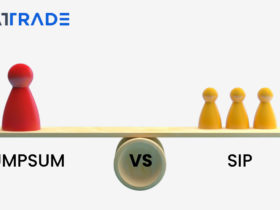When you invest in mutual funds, one crucial choice is the way you want to hold them. You have two primary options: Demat Mode and Folio Mode.
Both have their benefits and are appropriate for various kinds of investors.
We will see the major difference between these two modes and will let you decide which mode of investment is best for you.
Demat mode: In this mode, your Demat units are stored in dematerialized format in your Demat account – like stocks. You must possess a Demat + trading account with us and it is much beneficial for you as we provide zero brokerage.
Key Features:
- Consolidated Holdings: Allows you to hold several financial instruments—such as stocks, bonds, and mutual funds—under a single account, providing you with a consolidated picture of your portfolio.
- Ease of Transfer: Facilitates easy transfer of units from one account to another, which can be useful for gifting or inheritance.
- Transaction Process: Your transactions are done through us, and units are credited to your Demat account when you purchase.
- Associated Expenses: May comprise expenses such as yearly maintenance fees for the Demat account and charges on transactions levied by the DP.
Considerations:
- Systematic Transactions: Certain systematic plans, such as Systematic Transfer Plans (STPs) and Systematic Withdrawal Plans (SWPs), may not be offered in Demat form.
- Processing Time: Crediting units to the Demat account could take a fraction of time more than SOA mode (Statement of Account mode).
When to Opt for Demat mode?
- You already trade Stocks or ETFs
- You want a simplified view of all investments
- You prefer less paperwork & platform ease
- You invest in Exchange-Traded Mutual Funds (ETFs)
- You want to easily roll over Mutual Funds
- You don’t mind paying small annual fees
Folio mode: Folio mode implies your units of the mutual fund are directly held with the Asset Management Company (AMC) in separate folios, usually handled by RTAs (Registrar and Transfer Agents) such as CAMS or KFintech.
Key features:
Folio Number: Every investment in a mutual fund by an AMC is assigned a folio number that allows the AMC to monitor your investment history, transactions, nominee information, etc.
·. Direct or Regular Plan Access:
o Direct Plan: Invest through AMC websites or platforms such as MF Utility or CAMS – reduced expense ratio, increased returns.
o Regular Plan: Invest through our brokerage – they assist in paperwork, but charge commission (incorporated in fund expense).
· No Requirement of Demat Account: Folio mode is not dependent on the structure of the stock market. You don’t require a broker or DP. Your investments are tracked and handled directly by the AMC.
· SIP and Lump Sum Friendly: SIPs can be easily initiated, stopped, or changed. Lump sum investments can be done at any time without brokerage or platform limitations.
· Consolidated View Possible via RTAs: Platforms such as CAMS, KFintech, MF Central, and MF Utility enable you to monitor several folios of various AMCs in one location.
Considerations:
- Multiple Folios = Fragmentation:
- Investing in more than one AMCs will land you with distinct folios
- Need to keep tabs on all folios except if you go in for consolidation platforms (e.g., CAMS+)
- No Single Portfolio with Stocks:
- Contrary to Demat mode, you’ll not view mutual funds together with stocks or ETFs
- Redemption Time:
- While usually speedy, certain AMCs can take 1–3 business days to settle the redemptions
- Less Handy for Traders:
- Folio mode is not for buying and selling frequently as with stock
When to Opt for Folio Mode?
- You invest in mutual funds only
- You desire direct plans and wish to steer clear of charges
- You are a long-term investor or SIP-oriented
- You are not keen on stocks or active dealing
- You like to manage your portfolio without the intervention of intermediaries
Difference between Demat and Folio mode:
Feature | Demat Mode | Folio Mode |
Definition | Investments held in a Demat account electronically | Investments held directly with the mutual fund company |
Used For | Stocks & mutual funds (via stock exchanges) | Mutual funds (direct or via distributor) |
Account Required | Demat account with a broker or DP | Folio number with each AMC |
Central Authority | NSDL/CDSL (Depositories) | AMC or RTAs like CAMS/KFintech |
Broker Needed | Yes | No |
Charges | No maintenance charges | Usually no maintenance charges |
Ease of Use | Unified view of all holdings, easy trading | May need to track multiple folios across different AMCs |
Best For | Active traders, consolidated view across assets | Long-term mutual fund investors |
Disclaimer: Investments in the Securities market and Mutual Funds are subject to market risks. Read all the related documents carefully before investing | The securities are quoted as an example and not as a recommendation | Brokerage will not exceed the SEBI-prescribed limit | Margins will be collected as per the exchange norms.








